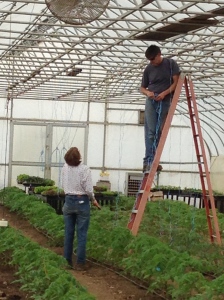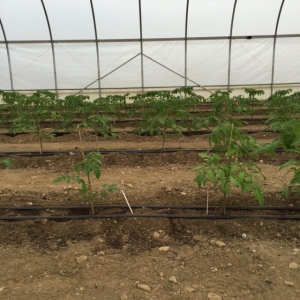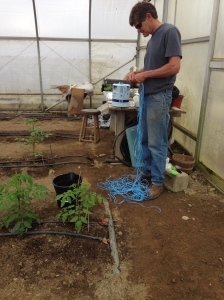Can you believe it – it’s already tomato time!
Some of the transplants have been in the ground for two weeks now, and with this week’s past spell of warm weather, the tomato plants have grown drastically. The plant on the left was planted just yesterday, while the plant on the right was transplanted two weeks ago – look at the size difference! Observe also that the plant on the right has much more foliage on it than the younger counterpart on the left.
When the plants reach a height of roughly 12-15 inches, it is time to start supporting them. You might notice that there are bamboo stakes currently supporting the plants – but as the tomatoes begin to grow upward and outward, these stakes will no longer be sufficient to support the height and weight of the plant. The bamboo stakes are more of a filler support system until we have the time and need to institute a stronger support system.
There are many different types of supported culture systems to provide a physical structure for the tomato plants to grow on. Commonly used systems are stakes, cages, and trellises.
In a traditional stake and weave model, six foot wooden stakes are driven between every other tomato plant. Twine is then strung across the stakes. The first stretch of twine is located roughly ten inches off the ground, with each  consecutive piece being strung 8 inches above the last. Tomatoes are stabilized by weaving the branches back and forth between the rows of twine. Alternatively, some growers will face forward and run one row of twine down the left side of the plants, the next one down the right, etc. to form the same woven pattern as weaving each plant individually.
consecutive piece being strung 8 inches above the last. Tomatoes are stabilized by weaving the branches back and forth between the rows of twine. Alternatively, some growers will face forward and run one row of twine down the left side of the plants, the next one down the right, etc. to form the same woven pattern as weaving each plant individually.
The cage model is quite common in home garden systems as it takes less effort to put into place and oftentimes provides many of the same benefits of staking and weaving. A wire cage is usually placed around the tomato plant and the branches are lifted to be supported by the cage, much like the wires in a stake and weave system. Tomatoes can be harvested very easily through the openings in the cage, which is another reason this system is so appealing to the home gardener.
At The Berry Patch, we use a trellis type system to support our tomato plants. As noted before, we begin our trellising when the plants reach a height between 12 and 15 inches. In this system, twine is hung from the heavy top supports of the greenhouse and tied and secured at the bottom of each every tomato plant. As the plants grow, they are trained to one or two main stems and each stem is wound around twine as it grows. Tomato plants that are trellised tend to produce fruits that are often bigger and ripen earlier than plants trained in other systems.
Tomato trellising and training is a never-ending job. As long as the tomato is growing, it is likely the branches and vines will need to be repositioned so that the plant remains properly supported. The Berry Patch has over two hundred tomato plants that each need their own length of twine cut and hung. Each of these plants will get individually trained so they are supported in the best way to encourage fruit growth. This means that upwards of hours a week can be spent on training alone – not to mention pruning, harvesting, marketing and selling!!!
Questions about the different types of supported culture systems? Feel free to contact us and we would be happy to provide our advice.
“It’s difficult to think anything but pleasing thoughts while eating a homegrown tomato.” – Lewis Grizzard

